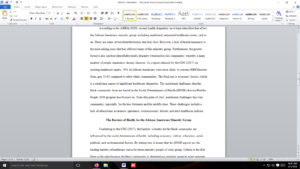Health promotion prevention
Select an ethnic minority group that is represented in the United States (American Indian/Alaskan Native, Asian American, Black/African American, Hispanic/Latino, Native Hawaiian, or Pacific Islander). Using health information available from Healthy People, the CDC, and other relevant government websites, analyze the health status for this group.
In a paper of 1,000-1,250 words, compare and contrast the health status of your selected minority group to the national average. Include the following:
- Describe the ethnic minority group selected. Describe the current health status of this group. How do race and ethnicity influence health for this group?
- What are the health disparities that exist for this group? What are the nutritional challenges for this group?
- Discuss the barriers to health for this group resulting from culture, socioeconomics, education, and sociopolitical factors.
- What health promotion activities are often practiced by this group?
- Describe at least one approach using the three levels of health promotion prevention (primary, secondary, and tertiary) that is likely to be the most effective in a care plan given the unique needs of the minority group you have selected. Provide an explanation of why it might be the most effective choice.
- What cultural beliefs or practices must be considered when creating a care plan? What cultural theory or model would be best to support culturally competent health promotion for this population? Why?
Cite at least three peer-reviewed or scholarly sources to complete this assignment. Sources should be published within the last 5 years and appropriate for the assignment criteria and public health content.
Prepare this assignment according to the guidelines found in the APA Style Guide, located in the Student Success Center. An abstract is not required.
This assignment uses a rubric. Please review the rubric prior to beginning the assignment to become familiar with the expectations for successful completion.
Answer preview
According to the AHRQ (2020), several health disparities have been identified that affect the African Americans minority group, including nutritional, uninsured healthcare access, and so on. These are some of the identified issues that they face. However, a lack of health insurance is the most arising issue that has affected many of this minority group. Furthermore, the genetic factor is also another identifiable health disparity witnessed in this community, whereby a large number of people experience chronic illnesses. In a report released by the CDC (2017) on creating healthcare equity, 50% of African Americans were more likely to contract HBP illnesses from ages 35-65 compared to other ethnic communities. The final one is economic factors, which is a catalyzing aspect of significant healthcare disparities. The nutritional challenges that the black community faces are based on the Social Determinants of Health (SDOH) that the Healthy People 2020 program has focused on. From this point of view, nutritional challenges face this community, especially for the less fortunate and the middle class. These challenges include a lack of educational awareness, ignorance, socioeconomic factors, and strict healthcare policies.
[1259 Words]

Health promotion prevention

